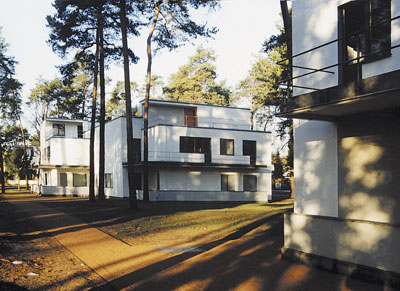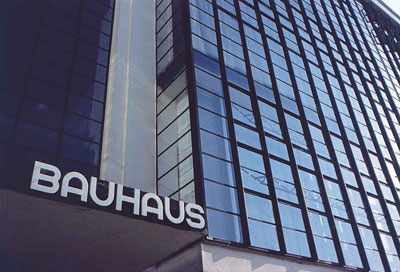Bauhaus Year 2009
by Jay Brunhouse
Over the flat farmland of Germany’s Thüringen (Thuringia) state, my ICE TD, a 5-carriage train, sped to 125 mph with its tilting mechanism mastering the curves beautifully.
I was on the trail of the Bauhaus school, from Weimar, where the school began, to Dessau, where it blossomed, to Berlin, where the most important and influential school of design that combined crafts and the arts met its ultimate death at the hands of the Nazis.
On the 90th anniversary of the founding of the Bauhaus, Weimar, the Weimarer region, Jena and Erfurt will muster in Bauhaus Year 2009 — for the first time on such a large scale — a comprehensive series of exhibitions and events highlighting the background, the historical and intellectual roots and the origins of the Bauhaus philosophy.
Everyone sitting on a chair with a tubular steel frame, using an adjustable reading lamp or living in a house partly or entirely constructed from prefabricated elements owes a debt to Bauhaus “masters” and “apprentices.” The designs that Bauhaus originated brought together art and technology and led the way for our modern industrial culture.
Weimar
Architect Walter Gropius was appointed on April 1, 1919, to establish the “State Bauhaus Weimar.” On April 11, Gropius arrived in Weimar to sign his contract while, only a riot crowd away, the National Constituent Assembly was deliberating the shape of the Weimar Constitution.
Gropius’ invited masters and apprentices moved into Weimar’s handsome School for Building & Architecture, built by Belgian architect Henry van de Velde in 1904 and listed as a UNESCO World Heritage Site in 1996. It now houses Bauhaus University.
Weimar, although relatively free from political unrest, was the city of Goethe and Schiller — the cultural city of Europe in its day — and its citizens mistrusted everything new-fangled.
The Weimar school was extremely unpopular. The Bauhaus art students were regarded by the townspeople as dirty, lazy, promiscuous and conceited. Defacements of public buildings and nude sunbathing angered the residents.
At the beginning of 1921, Paul Klee came to the Weimar Bauhaus. In 1922 the renowned Russian painter Wassily Kandinsky joined Klee on the Bauhaus staff. In 1923 Georg Muche’s experimental Haus am Horn (also listed by UNESCO in 1996) was completed where the students’ vegetable garden had been.
In November 1923, Germany began a period of prosperity. The school’s following term was the most successful ever. Endless theorizing ceased and all workshops began producing things. The Thüringen mint commissioned the school for banknotes, but by the time they were issued rampant inflation required even higher denominations. The school’s direction moved to the idea of industrial design and mass production of cheap, quality products.
By 1924, a right-wing government replaced the Socialist Bauhaus-supporting parliament. Military searched Gropius’ flat but found nothing. The Thüringen ministry officials announced that teaching contracts could be offered only for six months and that only half of the necessary support was available. Three days later Gropius announced the Bauhaus would be closed at the end of March 1925.
The city of Dessau offered a generous proposal. Dessau’s mayor, a Liberal with Socialist party support, secured a budget for the school that far surpassed the one in Weimar.
Dessau
Most of the staff and students were delighted to move to Dessau. Everywhere was within walking distance of rivers and open fields. On Dec. 4, 1926, more than 1,000 guests attended the opening of the new Bauhaus building that was designed by Walter Gropius and equipped by the Bauhaus workshops.
A new kind of industrial design moved past the signature Bauhaus flat-roof buildings, and Bauhaus became serious, practical and effective. “Young Masters” introduced new ideas.
Breuer developed bent-steel chairs based on the design of bicycle handlebars, with comfortable seats of leather or cloth. Scheper developed textured and patterned Bauhaus wallpaper and it became the most successful commercial product of the school. It sold four and a half million rolls in its first year.
Leaving the Bauhaus building, only a 5-minute walk away, I was delighted to visit the small Masters’ Houses estate built at the same time as the Bauhaus. Gropius himself had a detached house adjacent to three pairs of semidetached houses for the staff.
Kandinsky and Klee shared one of the staff houses, but the large, transparent glass wall that Gropius had designed allowed everyone to peer into the house. It so bothered Kandinsky that he took it upon himself to paint the inside of the glass wall white. Gropius was opposed to colored interiors, but Kandinsky had the rooms painted — the dining room in black and white.
Kandinsky was in his circles period, so he directed the Bauhaus workshop to produce furniture for the dining rooms and bedrooms featuring as many circles as possible.
I noticed the large number of original fittings and admired the unique color schemes in the rooms. Designers counted more than 40 colors in Feininger’s house and 172 different shades in Kandinsky and Klee’s house. Aircraft from Dessau’s Junkers factory passed overhead daily and, in 1929, on Klee’s fiftieth birthday, according to his wife, one dropped so many flowers and presents on the flat roof of his house that the roof collapsed.
In January 1928 Gropius suddenly resigned to work in Berlin as an architect. He approached Mies van der Rohe to replace him, but van der Rohe refused, so the Swiss Hannes Meyer, a Marxist, was appointed director. Staff and students were dissatisfied.
Student political involvement increased. A Communist cell was formed. The city of Dessau forced Meyer and Communist students to resign in 1930. Meyer went to Russia and renowned architect Ludwig Mies van der Rohe was appointed director in April. Van der Rohe was determined to avoid political involvement and so dismissed politically active students.
In November 1931, Nazis captured the elections for the municipal council in Dessau. The Nazis considered the Bauhaus Bolshevik and clearly Jewish because of the flat roofs. The school was closed on Sept. 30, 1932. Nazis broke the windows and threw out files and fittings of the Bauhaus building. It was restored in 1975-76. In 1996, the UNESCO World Heritage Site listed the Dessau Bauhaus building and the Masters’ Houses.
Berlin
In 1932, van der Rohe decided to continue the school as a private school in Berlin with support only from its royalties. He leased a disused telephone factory in Berlin’s Steglitz district.
Adolph Hitler’s appointment as German Chancellor on Jan. 30, 1933, signaled the end of the 1919 Weimar Constitution. The lifespan of the Bauhaus was precisely that of the Weimar Republic.
Berlin police, acting on instructions of the new Nazi government, closed the Bauhaus on April 11, 1933, and arrested 32 students.
Over the course of the following years, the most prominent Bauhaus teachers emigrated. In 1933, Josef Albers went to the US, Kandinsky went to France and Klee went to Switzerland. Walter Gropius went to Britain in 1934 and to the US in 1937. Van der Rohe also went to the US in 1937.
Reference: “Bauhaus,” Frank Whiteford (published by Thames & Hudson, London and New York, 1984; reprinted 2000).
Bauhaus Archiv
The frosting of my May ’08 trip tracing the Bauhaus came in Berlin when I revisited the Mediterranean-white, Gropius-designed Bauhaus Archiv Berlin.
I was surprised to see that the exquisite examples of furniture, tube chairs, tapestries, pottery, house wares, graphics and wallpaper that I consider modern today were sketched and realized more that 70 years ago. Paintings by Kandinsky and Klee grace the walls.
I thank the German National Tourist Office (www.cometogermany.com) for inviting me and arranging this trip. I stayed in Weimar at Hotel Elephant (phone +49 [3643] 8020, www.starwood.com/luxury), with rates from €110 (about $150). In Dessau I stayed at the Steigenberger Hotel Fürst Leopold (phone +49 [340] 25150, www.steigenberger.com), with rates from €62 ($85). In Berlin my home was the NH Hotel Berlin Mitte (phone +49 [30] 203760, www.nh-hotels.com/NHBerlinMitte), from €99 ($135). Air transportation was by Lufthansa.


